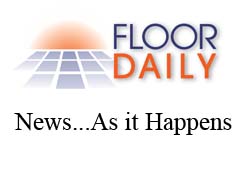Study: Global Flooring Demand to Hit 14.7B Square
Cleveland, OH, January 31, 2007--According to a study released by the Freedonia Group, Inc., a Cleveland-based industry research firm, world demand for flooring and carpets is projected to climb 4.1 percent annually through 2010 to 14.7 billion square meters, valued at $162 billion. The study is entitled "World Flooring & Carpets." According to the study, product demand will be stimulated by a pickup in nonresidential building construction as world economic growth accelerates and industrialization efforts continue in less developed parts of the world. China will record the largest gains of any country and will surpass the U.S. to become the biggest floor covering market in the world. Sales growth is also expected to be strong in India, as well as in lower-volume markets such as Indonesia, Turkey, Iran, the Ukraine and Saudi Arabia. The study said that flooring and carpet demand in developed parts of the world will climb, although the pace of increase will be less robust than in developing countries. Product sales in Western Europe will accelerate through 2010, and floor covering demand in Japan will exhibit renewed strength following an extended period of decline. In the U.S., flooring and carpet sales will be spurred by increases in nonresidential construction and motor vehicle production. However, new housing starts in the nation are expected to decline, preventing the floor covering market from expanding at a faster rate. The study said that demand for nonresilient flooring (ceramic, wood, laminate, etc.), which is by far the most popular type of floor covering worldwide, will outpace sales of both resilient flooring (which includes vinyl, linoleum and rubber products), and carpet and rugs through 2010. Increases will be driven by the durability and ease of maintenance offered by nonresilient flooring, and supported by growing consumer preference for high-end and natural hard surface flooring products. It said suppliers of carpets and rugs, the second most widely used type of floor covering, will benefit from a pickup in building construction expenditures in Western Europe, rising construction activity in other parts of the world and, to a lesser extent, growth in global motor vehicle production. Demand for resilient flooring, which accounts for the remainder of floor covering sales, will be stimulated by its comparatively low cost, as well as by favorable performance characteristics like high underfoot comfort, noise absorption, durability and wear resistance.
Related Topics:RD Weis
